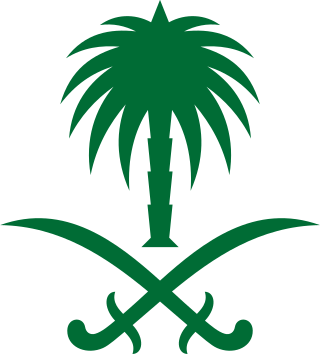
The history of Saudi Arabia as a nation state began with the emergence of the Al Saud dynasty in central Arabia in 1727 and the subsequent establishment of the Emirate of Diriyah. Pre-Islamic Arabia, the territory that constitutes modern Saudi Arabia, was the site of several ancient cultures and civilizations; the prehistory of Saudi Arabia shows some of the earliest traces of human activity in the world.

Wahhabism is a reformist religious movement within Sunni Islam, based on the teachings of 18th-century Hanbali cleric Muhammad ibn 'Abd al-Wahhab. The term "Wahhabism" is primarily an exonym ; it was not used by Ibn 'Abd al-Wahhab himself or adherents to the movement, who typically prefer to be called "Salafi". The movement's early followers referred to themselves as Muwahhidun derived from the term Tawhid. The term "Wahhabi" has also been deployed by various outsiders as a sectarian and Islamophobic slur.

Abdulaziz bin Abdul Rahman Al Saud, known in the West as Ibn Saud, was an Arab political and religious leader who founded Saudi Arabia – the third Saudi state – and reigned as its first king from 23 September 1932 until his death in 1953. He had ruled parts of the kingdom since 1902, having previously been Emir, Sultan, and King of Nejd, and King of Hejaz.

The House of Saud is the ruling royal family of Saudi Arabia. It is composed of the descendants of Muhammad bin Saud, founder of the Emirate of Diriyah, known as the First Saudi state (1727–1818), and his brothers, though the ruling faction of the family is primarily led by the descendants of Abdulaziz bin Abdul Rahman, the modern founder of Saudi Arabia. It forms a subtribe of the larger prominent ancient Banu Hanifa tribe of Arabia, from which well known 7th century Arabian theologist Maslama ibn Ḥabīb originates. The most influential position of the royal family is the King of Saudi Arabia, an absolute monarch. The family in total is estimated to comprise 10,000 to 20,000 members; however, the majority of power, influence and wealth is possessed by a group of about 2,000 of them. Some estimates of the royal family's wealth measure their net worth at $1.4 trillion.This figure includes the market capitalization of Saudi Aramco, the state oil and gas company, and its vast assets in fossil fuel reserves, making them the wealthiest family in the world and the wealthiest in recorded history.

Abdul Rahman bin Faisal Al Saud was the last emir of Nejd, reigning from 1875 to 1876 and from 1889 to 1891. He was the youngest son of Emir Faisal bin Turki bin Abdullah and the father of Abdulaziz, the founder of the Kingdom of Saudi Arabia.
Saud bin Abdulaziz Al Saud ruled the First Saudi State from 1803 to 1814. Saud annexed Mecca and Medina from the Ottoman Empire making him the first Al Saud ruler who received the title of the servant of the Two Holy Cities. During his rule the state experienced a significant level of strength and expansion for which he was called Saud Al Kabeer or Saud the Great.

Diriyah, formerly romanized as Dereyeh and Dariyya, is a town and governorate in Saudi Arabia located on the northwestern outskirts of the Saudi capital, Riyadh. Diriyah was the original home of the Saudi royal family, and served as the capital of the Emirate of Diriyah under the first Saudi dynasty from 1727 to 1818. Today, the town is the seat of the Diriyah Governorate—which also includes the villages of Uyayna, Jubayla, and Al-Ammariyyah, among others—and is part of Ar Riyad Province.

The Rashidi dynasty, also called Al Rashid or the House of Rashid, was a historic Arabian House or dynasty that existed in the Arabian Peninsula between 1836 and 1921. Its members were rulers of the Emirate of Ha'il and the most formidable enemies of the House of Saud, rulers of the Emirate of Nejd. They were centered in Ha'il, a city in northern Najd that derived its wealth from being on the route of the Hajj pilgrimage to Mecca, and was also a commercial center. The rulers of Ha'il were the sons of Abdullah bin Rashid, founder of the dynasty.
Faisal bin Turki Al Saud was the second ruler of the Second Saudi State and seventh head of the House of Saud.

Sa'ad bin Abdul Rahman Al Saud (1890–1915) was the brother of Abdulaziz, Emir of Nejd. He was one of Abdulaziz's most devoted supporters and a key lieutenant in his early military campaigns.

Madawi al-Rasheed, is a British citizen of Saudi origin and a professor of social anthropology. Al-Rasheed has held a position at the Department of Theology and Religious Studies in King's College London and as a Visiting Professor at the Middle East Centre at the London School of Economics and Political Science. She gives occasional lectures in the United States, Europe, and the Middle East. She is the granddaughter of Muhammad bin Talāl al-Rashid, the last prince of the Emirate of Ha'il, which was conquered by the Al-Saud in the early 20th century. She has written several books and articles in academic journals on the Arabian Peninsula, Arab migration, globalisation, gender, and religious transnationalism. As of 2016, she is a Visiting Research Professor at the Middle East Institute at the National University of Singapore.

Bandar bin Abdulaziz Al Saud was the tenth son of King Abdulaziz. At the time of his death, he was the eldest surviving member of the ruling branch of the House of Saud.

The Unification of Saudi Arabia was a military and political campaign in which the various tribes, sheikhdoms, city-states, emirates, and kingdoms of most of the central Arabian Peninsula were conquered by the House of Saud, or Al Saud. Unification started in 1902 and continued until 1932, when the Kingdom of Saudi Arabia was proclaimed under the leadership of Abdulaziz, known in the West as Ibn Saud, creating what is sometimes referred to as the Third Saudi State, to differentiate it from the Emirate of Diriyah, the First Saudi State and the Emirate of Nejd, the Second Saudi State, also House of Saud states.
The Al ash-Sheikh, also transliterated in a number of other ways, including Al ash-Shaykh, Al ash-Shaikh, Al al-Shaykh or Al-Shaykh is Saudi Arabia's leading religious family. They are the descendants of Muhammad ibn Abd al-Wahhab. In Saudi Arabia, the family is second in prestige only to the Saudi royal family, the Al Saud, with whom they formed a power-sharing arrangement nearly 300 years ago. The arrangement, which persists to this day, is based on the Al Saud maintaining the Al ash-Sheikh's authority in religious matters and the Al ash-Sheikh supporting the Al Saud's political authority.

The Arabian Peninsula People's Union was a Nasserist political party in Saudi Arabia. The APPU was founded in 1959 by Nasser Al Saeed whilst in exile in Beirut. Saeed had been exiled due to his leadership of the ARAMCO strikes in 1956. The APPU was regarded as one of the most important and most diverse opposition groups.
Muhammad bin Saud Al Muqrin, also known as Ibn Saud, was the emir of Diriyah and is considered the founder of the First Saudi State and the Saud dynasty, which are named for his father, Saud bin Muhammad Al Muqrin. His reign lasted between 1727 and 1765.
The Arab National Liberation Front was an exile-based Saudi opposition movement. ANLF was founded in Cairo in December 1962, through the merger of the National Liberation Front(جبهة التحرير الوطني) and the Free Princes Movement. Talal bin Abdulaziz became the general secretary of ANLF. The formation of a 15-member political bureau was announced when the organization was founded.

Sectarianism in Saudi Arabia refers to the Saudi government's "top-down push towards sectarian polarization" between the Sunni majority, and Shi'ite minority. This encompasses anti-Shi'ite policies by the Saudi regime, as well as tensions between the Sunni majority and the Shi'ite minority. The Saudi government is often viewed to be oppressing the Shi'ite community, who constitute up to 15% of the Saudi population. This occurs against the backdrop of the broader Iran-Saudi Arabia proxy conflict, since Iran is a Shi'ite republic.
Tarfa bint Abdullah Al Sheikh was one of the spouses of Abdulaziz bin Abdul Rahman, Emir of Nejd, and the mother of Princess Noura and King Faisal.

Saudi Founding Day, officially the Founding Day, is a public holiday in Saudi Arabia celebrated annually on February 22 to commemorate the enthronement of Muhammad bin Saud as the emir of the oasis town of Diriyah in 1727 following the death of his father Saud al-Muqrin, the eponymous ancestor of the al-Saud family. His hereditary succession is considered as the prelude to the inception of the First Saudi State, the antecedent to the Second Saudi State and present-day Kingdom of Saudi Arabia. It was founded in 2022 on its 295th anniversary when King Salman bin Abdulaziz issued a royal decree that designated it as a legal holiday to be observed as per the Gregorian calendar. It is one of the three non-religious national holidays observed in the country, other being the Saudi National Day and Saudi Flag Day.














